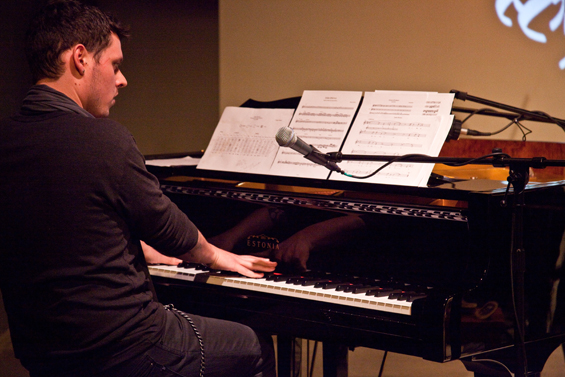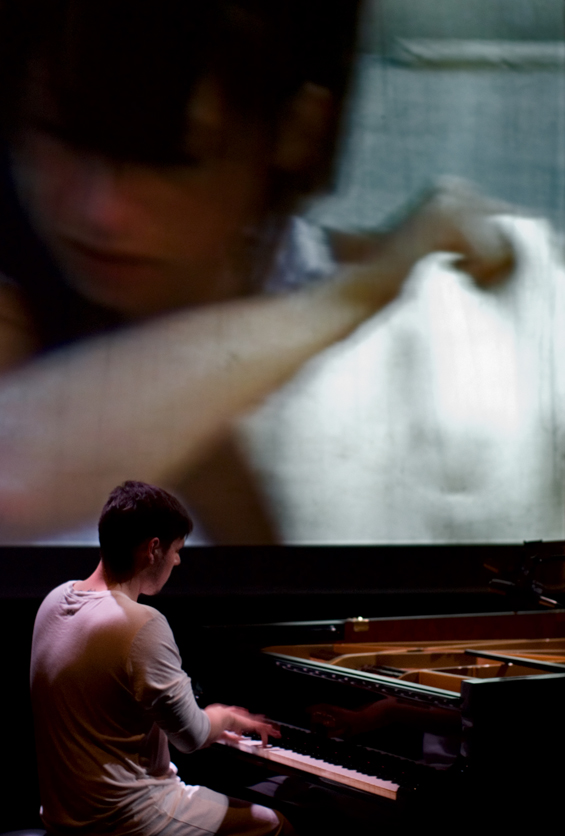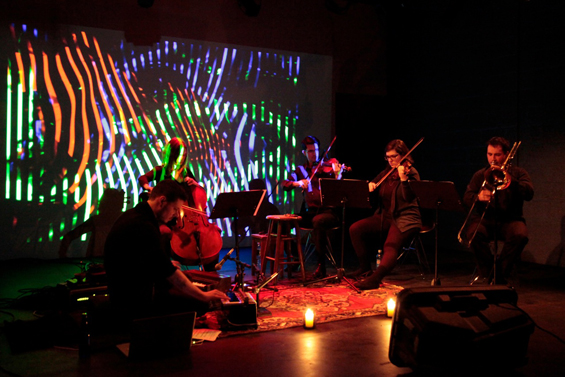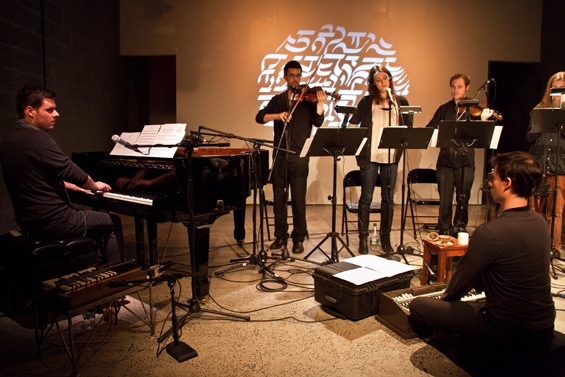Articles
Randy Gibson
Ezekiel Honig
Albums
17 Pygmies
A Dancing Beggar
A Guide For Reason
Alonefold
Gabriel Ananda
Antonymes
Arborea
Art Department
Baker & thisquietarmy
Bee Mask
Richard Chartier
Seth Cluett
Daedelus
Deep Magic
Dentist
Kyle Bobby Dunn
Dominik Eulberg
Fabric
Fancy Mike
Forrest Fang's Sans Serif
Randy Gibson
Mark Hakonen-Meddings
Hana
Ezekiel Honig
Kode9 and the Spaceape
Akira Kosemura
Logreybeam
Manik
Mokira
Murcof
BJ Nilsen & Stilluppsteypa
M. Ostermeier
Posthuman
Prefuse 73
Pulseprogramming
Quiet Evenings
May Roosevelt
M. Ruhlmann & B. Bailey
Savaran
Simko
Tape
Tokyo Bloodworm
Yamaoka
Compilations / Mixes
Ata
Cloud 11
Echocord Jubilee Comp.
Era One
M.A.N.D.Y.
Nick Warren
EPs
A Guide For Reason
Autechre
Circle Traps
Deepbass
DJ Duke
Finesse
Mokira
Rone
Nigel Samways
Janek Schaefer
Semtek
Tracey Thorn

Randy Gibson performing Doleo Æternus, NYC, November 2009
photo:
Travis Dubreuil
TEN QUESTIONS WITH RANDY GIBSON
Randy Gibson has accomplished a great deal since moving to New York City following a stint at the University of Colorado and marimba studies in Japan with Keiko Abe during the summer of 1998. In 2003, he began composition studies with the legendary La Monte Young, a development that included the study of Raga singing in the Kirana tradition with Young and Marian Zazeela. Gibson has also established himself as the artistic director of Avant Media, which presented its second annual Avant Music Festival in New York City during February 2011 and premieres of Gibson's own Apparitions of The Four Pillars (or, in full, Apparitions of The Four Pillars with Their Lowest Additive Primes as limited to the 3rd, 7th, 9th, and 11th New Primes chosen Cyclically, The Toll of Premonition, The Memorial Connector over the Outlying Primal Abyss, and The Mid-Winter Ending) as well as works by John Cage and Georges Aperghis. The recent CD release of Gibson's Aqua Madora, a piano-centered work rooted in just intonation, will undoubtedly and deservedly raise his profile further, and it is upon this marvelous work that a generous portion of the ensuing discussion centers.
Randy Gibson: "Aqua Madora (Chordal Excerpt)" (Aqua Madora, Avant Media)
1. For the sake of context, I'm wondering if you could tell us a little bit about who you are and your background. I know that you're currently living in Brooklyn and that your studies with La Monte Young began in 2003 but not a whole lot beyond that.
Well, I grew up in Boulder Colorado on a little farm. I went to a Montessori school and generally caused a ruckus; I always wanted to chart my own way, and I was particularly rough on the music teachers at school. I started playing the marimba when I was probably 7 or 8. In high school I was a very good performer, but I became really interested in John Cage and Fluxus and started to compose work that reflected that—mostly percussion-based things, chance operations, chaos… I did a few performance pieces around town. It was actually through my interest in Fluxus that I became aware of La Monte's work, his Composition 1960 #5 (where the performer releases a butterfly) particularly struck me. I went to the local Buddhist temple and sat on Sundays for a couple of years. I began taking an amazing interdisciplinary performance class led by the composer Michael Theodore at the University of Colorado, where I met a number of dancers and started writing pieces for their performances. After a very brief stint as a full-time composition student there, I moved to New York, which was really what I had always wanted to do.
2. You use just intonation in Aqua Madora and in your work in general. Though just intonation may be familiar to some textura readers, no doubt there are many for whom it's a bit of a mystery. Could you explain in basic terms exactly what is meant by just intonation?
Just intonation is basically a system of tuning that uses whole number ratios to create intervals. It's much simpler, in math terms, than equal temperament. There's usually a single fundamental in a work, for me it's always D, and the intervals relate back to that. But just like anything, it's all about what someone does with it. Kyle Gann has an excellent site that really delves into the details and lets you hear side by side the difference between just and equal intervals.
3. Can you talk a bit about the genesis of Aqua Madora, about how it developed as a project involving you and Ana Baer-Carrillo?
I had been working with Ana for quite a while when we started this piece. Sometime in 2005, she told me about a new piece she and Dani Beauchamp were working on about water and mourning and they were probably going to be performing with a guitarist. The early versions of Aqua Madora were actually intended to be played on a guitar, but it became really evident that there was more to this piece that needed to be explored. We set a date for the premiere to happen in Boulder in June, 2006. I went back to Colorado off and on during this period and spent a few months working on a friend's piano, developing the tuning and spending hours improvising over these sine wave drones and coming up with material. The version that premiered in 2006 was just under 30 minutes long and really intense. Dani performed alongside me, and the video was projected behind us. We burned rose incense, the first time I actually used incense in my work.
Over the performances that followed (in Mexico later that same year, then in Los Angeles in 2007) I improved both the tuning and what I was doing with it. Working alongside Ana and Dani was really special; a lot of the form of the piece comes from them. When we decided to do it in New York in 2008, I wanted to make it longer and we ended up making a new version that would be performed with just the video, without live dance.
It was during the preparation for this performance that La Monte gave me his blessing to really take this work to the next level.

Randy Gibson performing Aqua Madora, NYC, May 2008
Photo: Joshua Weiner
4. You began studying with La Monte Young in New York in 2003. How did that association come about? I'm guessing that he doesn't simply take anyone on as a student who expresses a desire to study with him. And did those studies end at a particular time or are they ongoing?
It was oddly enough a bit of a fluke. When I moved to New York I decided that I was going to get in contact with the composers who I really respected and try to study privately. I wish I could remember what I said in that first e-mail to La Monte, but I distinctly remember walking home one night and getting a call from a number I didn't recognize and it was La Monte and Marian. I had my first all-night composition lesson with them shortly after that call.
5. What was the particular nature of those studies? Did you visit him at his loft and play piano? Were the lessons focused on theory and/or raga studies? As a matter of curiosity, I'm wondering what your experience was like of visiting the Dream House for the first time.
In the beginning it was all focused on composition. I would come, usually late at night, and play recordings of what I had been working on, and we would talk about the piece, life, art, everything. It was a really total and wide-ranging education. Just amazing. I went to all of the raga concerts that their Just Alap Raga Ensemble was doing and, since 2005, I've been studying raga singing with them.
My first experiences at the Dream House were actually as the performance space for the raga concerts, filled with the tambura drone. When I finally got to experience The Base 9:7:4 Symmetry… (the sonic portion of the Dream House) it was an absolute revelation for me. I had been working with sine waves anyway, and to be utterly enveloped in this just wall of sound created only by sine waves was amazing. In the many hours I've spent there since that first visit it just keeps getting more and more interesting, and I begin to understand it more and more.
6. In the liner notes for the recording, you state that Aqua Madora's music is based on the three-note “mador” chord from Anger. Could you elaborate on what that means?
That piece has actually since been renamed to Doleo Æternus. It's a series of six chords that I began working on in early 2004. These six chords each got a name in Latin that had to do with sadness or mourning or anger. The second chord from this piece is called Mador and it's built of a D, an E, and an A or to put it in just intonation terms, the fundamental and a 9:8 and 3:2 above it. These six chords really became my obsession for a number of years, they still sort of are, and were the underlying basis for all of my work from this period. I would take one of the chords from Doleo Æternus as the jumping off point for creating a new work. Aqua Madora took me significantly further than most of the other ones in this group, but the drone you hear at the beginning of this recording, over which the Alap is performed, is this chord in its pure form.
7. You also mention that the raga tradition has permeated your work ever since you began studying raga singing with Young and Marian Zazeela. In what way specifically does that tradition appear in your work?
A lot of it has to do with the way I think about introducing pitches. The idea of badhat in the Alap section of a raga, where each pitch of the scale is slowly introduced is particularly intriguing to me. The Alap of Aqua Madora very slowly introduces each new pitch so it can be heard in relation to everything else—the listener can hear it in its simplest context and then is prepared for when, later in the piece, it gets used in more complex ways.
I think also the whole mysticism that surrounds raga performance has allowed the ritualistic aspects of my performances to become more refined and intentional.

Randy Gibson, Will Lang, and the Apparitions String Ensemble performing Apparitions of The Four Pillars with Their Lowest Additive Primes as limited to the 3rd, 7th, 9th, and 11th New Primes chosen Cyclically, The Toll of Premonition, The Memorial Connector over the Outlying Primal Abyss, and The Mid-Winter Ending at the 2011 Avant Music Festival, NYC, February 2011
Photo: Tear-N Tan
8. Obviously Young has had a profound impact on your artistic sensibility and overall approach. Can you talk a bit about the influence The Well-Tuned Piano has had on your work in general and Aqua Madora in particular?
Absolutely. The Well-Tuned Piano was a huge influence on Aqua Madora; without it I never would have even dreamed of attempting something like this piece. I got my copy of the DVD of The Well-Tuned Piano in The Magenta Lights on October 11, 2004, and I can look at my work very directly in two sections: those pieces that came before that, and those that came after. There was a big chunk of time from 2003-05 that I barely wrote anything and didn't really perform. I started work on what would become Doleo Æternus around this time, but had otherwise hit a plateau in my work and hearing The Well-Tuned Piano helped to change that. I think The Well-Tuned Piano, by its mere existence, has given us a precedent to make work that is utterly uncompromising.
Obviously there are mechanical aspects of the Aqua Madora, the drone sections particularly, that are directly the descendents of The Well-Tuned Piano, but it's also the sense of time. Once I stopped performing with the dance, and in other works without any sort of time constraints, my work got longer, but also found its natural rhythm. I pretty much never set a specific duration for my work any more.
I never got to see The Well-Tuned Piano performed live, but at the same time that I was beginning work on Aqua Madora and really beginning to find my voice, Charles Curtis did three performances of La Monte's Just Charles and Cello In The Romantic Chord at the Dream House that I attended with rapt adulation. That work has had the most direct influence on me, I think partially because it's focused on a single chord from a larger work (The Romantic Chord from The Well-Tuned Piano) and that's something that I've been interested in for a long while, expanding and exploring a single aspect.
9. Presumably other artists have had an impact on your development too. I'm wondering, for example, if Charlemagne Palestine might be another who has influenced you in some way. Could you talk a bit about some of the artists in addition to Young who've brought you to where you are today?
Definitely John Cage goes to the top of that list. It was because of his work that I first thought about writing music instead of performing it. As a percussionist, Steve Reich's work really appealed to me, and learning to play Marimba Phase was a huge part of my development. Early on Feldman was a big influence, and specific pieces like In C or Einstein On The Beach were also extremely formative. George Crumb is another, the drama of his work, and the extra-musical instructions were really interesting to me.
I'm not sure when I first heard Charlemagne Palestine's work, but it actually wasn't until fairly recently. In terms of that style, I'd actually point to Somei Satoh as being an influence, I think he was the first composer I heard use piano drones, on the album Litania —and that was combined with delay lines which I use extensively in my work.
10. What does the future hold for Randy Gibson as far as recording projects, performances, etc.?
My big project right now is called Apparitions of The Four Pillars. It's a sort of set of tuning theories and concepts that can manifest themselves in a number of ways, and is performed with a video sculpture created by Oscar Henriquez. Since February, 2010 I've been performing various aspects of this work, primarily on the Just Intonation Toy Organ, an instrument I developed for Doleo Æternus where I take old analog chord organs I find on eBay and elsewhere and tune them into various Just tunings. I released a tape last year (Analog Apparitions) on The Tapeworm label that heavily features this instrument.
I'm working on two new pieces for ensembles in New York that are focused aspects of Apparitions of The Four Pillars, one for the trombone quartet The Guidonian Hand and the other for the vocal ensemble Ekmeles. Those will both be performed during the 2012 Avant Music Festival in February. There's going to be a digital download edition of Aqua Madora sometime this summer, and then I'm planning to record something from the Apparitions series and doing a similar, limited edition release with that.

Randy Gibson and Ensemble performing Doleo Æternus, NYC, November 2009
Photo: Travis Dubreuil
May 2011
![]()